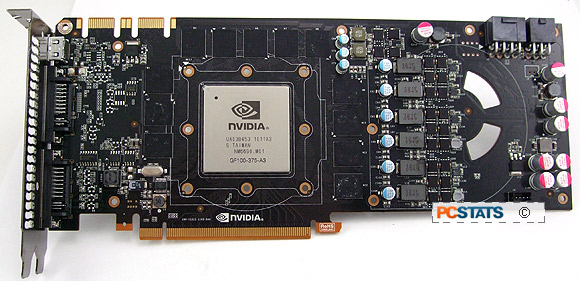Measuring in at 10.5" long and two expansion
slots wide, the ASUS ENGTX480-2D1-1536 is a videocard that you'll
need to measure your system out for. It's also quite heavy thanks
to a very substantial heatsink, so make sure to have it securely
insterted and locked into a PCI Express x16 slot, as well as screwed snugly
in place in your system chassis. It puts out a lot of heat so the usual
cautions about good case airflow are doubly important.

While nVidia's Geforce GTX 480 reference design is rated at a 250W TDP,
NVIDIA specs the Geforce GTX 480 as having a maximum operating temperature of
105 degrees celsius. That doesn't quite cover the question of how much heat
the ENGTX480-2D1-1536 actually generates... the answer is a lot of heat.

It gets hot enough that you
don't want to be touching the heatsink of this thing while the ASUS ENGTX480-2D1-1536 is
under load. Average GPU temperatures under load reached 95 degrees celsius, more than enough to
raise the ambient system temperature if this videocard is mounted inside of
a computer case.

No matter how you slice it,
being able to feel a blast of heat radiating off your videocard from a few
inches away does not bode well. If you are going to be fitting the ASUS
ENGTX480-2D1-1536 inside your case be prepared to invest in some serious system
cooling case fans.

The NVIDIA reference design heatsink is quite impressive. Four
heatpipes make direct contact with the GPU and are connected to a hefty array
of cooling fins.

To keep this videocard's performance competitive, NVIDIA had to
push the ENGTX480-2D1-1536 to the limit. It has a high-RPM fan that makes a lot
of noise. While acceptable noise levels are subjective and depend a lot on where
you do your computing, in the PCSTATS test labs I found the ENGTX480-2D1-1536 to
be loud enough to be distracting when the fan ramped up under load. It's
noticeably louder than any other videocard PCSTATS has tested from the NVIDIA
Geforce 200-series or Radeon HD 4000 or 5000 series.

A 250W TDP means the Geforce GTX 480 requires both an eight-pin
and a six-pin PCI Express power adapter to maintain stable power under load.
Both AMD
and NVIDIA make videocards that essentially team up two GPUs onto a single PCB (like the
Radeon HD 5970 or Geforce GTX 295), it's unlikely that NVIDIA will be able to
manage a single videocard that harnesses two Geforce GTX 480
GPUs.

With its 250W TDP, a single Geforce GTX 480 GPU is already approaching
the 300W TDP limit outlined for the ATX form factor. To make two of these GPUs
work on a single videocard, NVIDIA would have to lower the clocks of the GF100
GPU significantly, or transition to a more energy efficient 32nm production
process.

If you're an extreme enthusiast you can connect as many as three
ASUS ENGTX480-2D1-1536 videocards together in three-way SLI mode. To run two
Geforce GTX 480s together NVIDIA recommends power supplies with 950W load
capacities or greater, for three-way SLI systems you should be using a PSU with
at least 1200W load capacity, and expect peak system draw loads to exceed one
kilowatt.
With all that out
of the way, let's see how this little beastie from ASUS overclocks!
